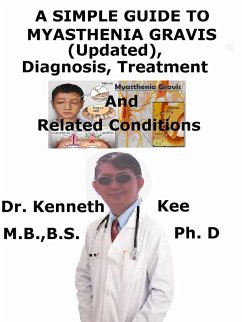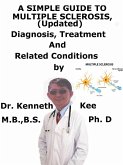This book describes Myasthenia Gravis (Updated), Diagnosis and Treatment and Related Diseases The knowledge of myasthenia gravis has greatly increased in recent years. 1. The antibody reaction in seronegative disease is now better featured with recognition of extra targets of antibody attack, such as MuSK. 2. In a recent study, an improved diagnostic sensitivity was obtained using anti-AChR ε subunit specific antibodies compared with the conventional AChR antibody testing. 3. Fab fragments of monoclonal antibodies directed against the main immunogenic region of the acetylcholine receptor have been proven to be effective in the prevention of passively transferred experimental autoimmune myasthenia gravis. 4. Photopheresis with blood lymphocytes exposed to ultraviolet radiation was proven to have a more prolonged remission than the conservative plasmapheresis in a recent study. 5. Mycophenolate mofetil is an immunosuppressive agent produced and initially used to prevent acute rejection of solid organ transplantation. 6. Recently, computed tomography guided percutaneous ethanol injection into the thymus has been proven to be effective, minimally invasive, and safe in the treatment of myasthenia gravis. 7. Specifically, the purpose of treatment should be to eradicate the autoimmune reaction to AChR particularly, without otherwise interfering with the immune system. 8. Myasthenia gravis is an autoimmune disorder featured by the weakness and fatigability of the voluntary muscles that is produced by auto-antibodies against the nicotinic AChR on the postsynaptic membrane at the neuromuscular junction. 9. It is almost always possible to confirm the diagnosis of myasthenia gravis with the present tests. 10. Modern treatment is highly effective and mortality of treated disease is almost zero. 11. Argenx, a Belgian drug maker, recently informed a successful phase 3 ADAPT trial of its experimental drug, efgartigimod. 12. In a global study of myasthenia gravis, an autoimmune disease that causes muscle weakness and fatigue, doctors found that surgical removal of an organ called the thymus (thymectomy) decreased patients' weakness, and their need for immunosuppressive drugs. Myasthenia gravis is a rare chronic autoimmune neuromuscular disease This condition occurs more in women than men at any age Myasthenia gravis literally means grave muscle weakness. Antibodies blocks the neurotransmitter junction, causing a neuromuscular illness The thymus gland may give incorrect instructions to developing immunity This results in the production of the acetylcholine receptor antibodies. Which unfortunately block the receptors at the neuromuscular junction This result in the receptors unable to generate a muscle contraction The muscle weakness usually increases during periods of activity There is weakness of the eye, neck, limbs and fatigue There is slurred speech and difficulty in swallowing There may a waddling gait and difficulty in breathing Treatment for myasthenia gravis is with anticholinesterase agents such as neostigmine Immunosuppressive drugs such as prednisone, cyclosporine, and azathioprine Thymectomy reduces symptoms in more than 70 percent of patients surgically Plasmapheresis in which intravenous immune globulin replaces the abnormal antibodies -An original poem by Kenneth Kee TABLE OF CONTENT Introduction Chapter 1 Myasthenia Gravis (Updated) Chapter 2 Causes Chapter 3 Symptoms Chapter 4 Diagnosis Chapter 5 Treatment Chapter 6 Prognosis Chapter 7 Motor Neuron Disease Chapter 8 Multiple Sclerosis Epilogue
Dieser Download kann aus rechtlichen Gründen nur mit Rechnungsadresse in A, B, CY, CZ, D, DK, EW, E, FIN, F, GR, H, IRL, I, LT, L, LR, M, NL, PL, P, R, S, SLO, SK ausgeliefert werden.









